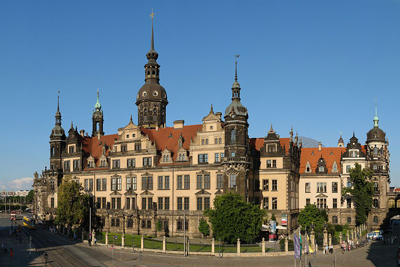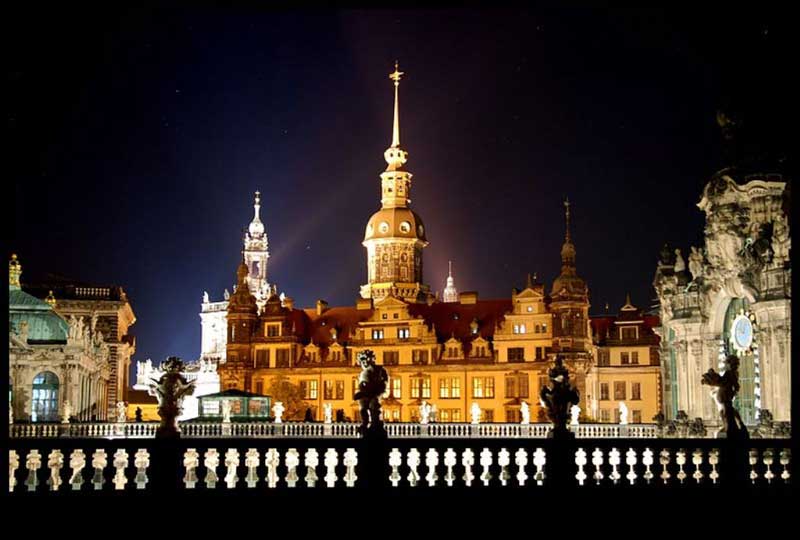
Considered one of the oldest buildings in Dresden, Germany, the Dresden Royal Palace originates in a medieval castle, built around 1200, which was one of the most important examples of Renaissance architecture in Germany. In the 15th century, it was extended to become a castle with four wings, and eventually, it took the current shape as a palace in the neo-Renaissance style in the middle of the 16th century. For around 400 years, it was the residence of the electors from 1547 to 1806, the Kings of Poland from 1697 to 1763, and also the residence of the Kings of Saxony from 1806 to 1918.
The Georgentor Gate of the Dresdner Castle, constructed in 1535 was originally the exit of the town’s fortress to the River Elbe, and the large mural of a mounted procession of the rulers of Saxony, known as the Fürstenzug or Procession of Princes, and located on the outer wall of the Stallhor or the Stable Courtyard, was originally painted between 1871 and 1876 to commemorate the 800th anniversary of the Wettin Dynasty. However, as the condition of the painted mural deteriorated, it was replaced with around 23,000 porcelain tiles between 1904 and 1907. The wall, with a length of 335 feet (102 m), is known as the largest porcelain artwork in the world.

After a major fire in 1701, Augustus the Strong, the then Elector of Saxony as well as the King of Poland, rebuilt a big portion of the castle in the Baroque style, when the collection room was created in the western wing. Subsequently, the Silver Room, Heraldic Room, and the completely mirrored Hall of Treasures were built between 1723 and 1726, while the Jewel Room, Ivory Room, and Bronze Room were built from 1727 to 1729. After that, more buildings were added between 1889 and 1901, and for modernization, the system for in-floor heating and electric lights was arranged in 1941.
The Dresden Royal Palace was severely damaged and was reduced to a roofless shell during the vicious firebombing by the British Royal Air Force on 13 February 1945, when almost ninety percent of Dresden was destroyed. During that time, three rooms of the Green Vault were obliterated, and several invaluable works of art and treasure were lost forever. Fortunately, the majority of the treasure housed in the Green Vault was saved as it was shifted to the Königstein Fortress in the early years of World War II, and survived the subsequent destruction of the Dresden Royal Palace.

Unfortunately, despite the insistence and sincere efforts of the volunteers and proactive public offices like the State Office for the Preservation of Historical Monuments, the Dresden University of Technology, and others, the communist rulers of East Germany did not show any intention to rebuild the Dresden Palace, except to install a temporary roof in 1946. Although attempts to restore the building resumed hesitantly in the 1960s with the installation of new windows, the process actually gained acceleration after the reunification of Germany, and since then, an amazing amount of reconstruction has occurred to re-arise the unique ensemble of the buildings in its old granger.
It was decided that the royal palace would be converted into a palace for arts and science, and in 1985 the project of reconstruction began in full swing to turn the ruined royal palace into a museum complex for Dresden State Art Collections. Today, the renovated Dresden Royal Palace houses five museum sections that include Grünes Gewölbe or the New Green Vault, Historiches Grünes Gewölbe or the Historic Green Vault, Kupferstich-Kabinett or the Cabinet of Prints, Drawings and Photographs, Rüstkammer or the Armoury, and Münzkabinett, the Coin Cabinet.

Located on the first and second floors of the western section of the renovated Dresden Palace, the Green Vault was originally named after the formerly malachite green painted column bases and capitals of the initial room, where Augustus the Strong used to keep and display his collection of treasure. Opened in 2004 on the second floor, and displaying the largest green diamond in the world, the New Green Vault is itself a real hidden gem of Europe. The reconstructed Historic Green Vault was opened in 2006 in the magnificent suite of rooms on the first floor where it had existed in 1733 at the time of its founder’s death. Consisting of nine rooms and one entrance chamber, the Historic Green Vault presents no less than 6,000 square feet (550 sq m) of mirrored surface and contains invaluable treasures that include works in gold, amber, ivory, Gemstone vessels and bronze statuettes, and many more.

Kupferstich-Kabinett or the Cabinet of Prints, Drawings and Photographs contains over half a million drawings, paintings, and photographs from the Middle Ages to the present, alongside the copper engraves or Kupferstiche, which give the collection its name. Apart from the works of the old masters like Michelangelo, Rembrandt, Lucas Cranach, Albrecht Dürer, and Caspar David Friedrich, along with the later artists like Henri Toulouse-Lautrec, Ernst Ludwig Kirchner, Käthe Kollwitz and Pablo Picasso, it also includes the contemporary artists like Wolfgang Tillmans, and Gerhard Richter. Similarly, along with the woodcuts of Lucas Cranach the Elder and engravings by Martin Schongauer, it also contains a collection of drawings and graphic art by Käthe Kollwitz. With its huge collection of approximately 515,000 objects created by more than 20,000 artists across eight countries, the Kupferstich-Kabinett is reckoned as one of the most significant museums of its kind in the world.

Rüstkammer or the Dresdner Armoury has an enviable and most valuable collection of weapons and armoury in the world, which includes around 10,000 objects, including helmets, shields, swords, daggers, and maces, pistols and rifles, riding equipment, and ceremonial clothes. A separate collection within the Dresdner Armoury, named the Turkish Chamber, displays more than 600 objects of art from the Ottoman Empire.
Münzkabinett, the Coin Cabinet in the Dresdner Castle, also called the Numismatic Cabinet, is one of the oldest museums in Dresden. Apart from a huge collection of coins from most countries of the world from antiquity to the present day, its collection of around 300,000 items includes early forms of money, historic banknotes, and bonds, historic and modern medallions, medals and insignia, minting dies for coins and medals, seals, even minting machines and equipment. The Numismatic Cabinet also serves as a centre of scholarly research and has a public library.

Apart from the museums, the English Stairway in the Dresdner Royal Palace became accessible again after working five years since 2010. The Baroque stairway, to be served as the main entrance for the museums, was reconstructed following the original historic plan, at an expense of four million Euros. After that, the Audience Hall, the small Ball Room, and three other historical rooms were restored and opened in 2019.

The newly created complex is also equipped with an extensive library, several lecture and study halls. During the summer months, the interested visitors are free to climb 327 steps to go the top of the 328 feet (100 m) tall octagonal Hausmannsturm to enjoy a spectacular view of the City of Dresden. The tower, one of the surviving parts of the main structure, dating back to 1400, is equipped with a Welsh dome covered with copper and an open lantern and adorned with an enormous Lock Clock.